Questions with Answers, Solution | Life Mathematics | Chapter 4 | 8th Maths - Exercise 4.5 | 8th Maths : Chapter 4 : Life Mathematics
Chapter: 8th Maths : Chapter 4 : Life Mathematics
Exercise 4.5
Exercise
4.5
Miscellaneous
Practice Problems
1. A fruit vendor bought some mangoes
of which 10% were rotten. He sold 33 1/3 % of the rest. Find the total number of
mangoes bought by him initially, if he still has 240 mangoes with him.

Solution:
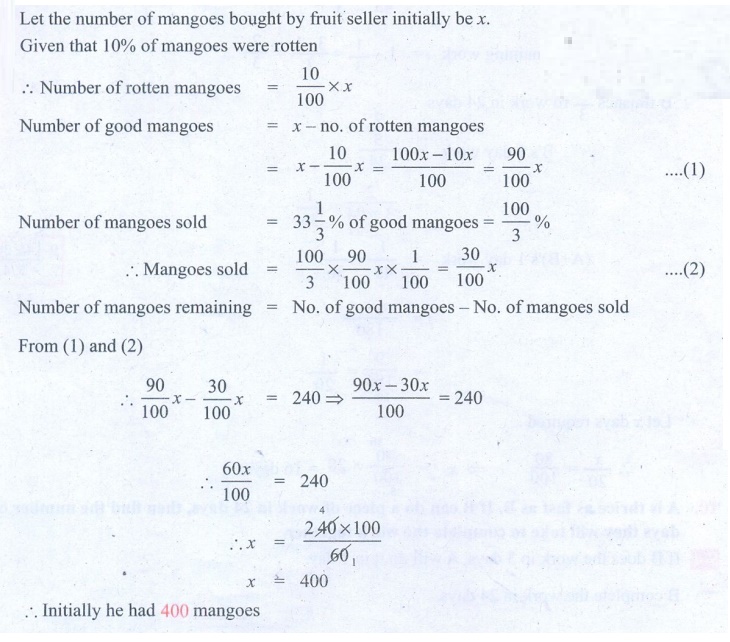
Solution 2:
Let the number of mangoes
bought by fruit seller initially be x.
Given that 10% of mangoes were
rotten
∴ Number of rotten mangoes = (10/100) × x
Number of good mangoes = x
− no. of rotten mangoes
= x – [10/100]x
= [100x – 10x ] / 100 = [90/100] x …….(1)
Number of mangoes sold = 33 (1/3)%
of good mangoes = 100/3%
∴ Mangoes sold = [100/3] × [90/100]x
× [1/100] = [30/100] x…….(2)
Number of mangoes remaining =
No of good mangoes − No. of mangoes sold
From (1) and (2)
∴ [90 /100]x – [30/100]x
= 240 ⇒ [90x − 30x ] /
100 = 240
∴ 60x /100 = 240
∴ x = [240 × 100] / 60
x = 400
∴ Initially he had 400 mangoes
2. A student gets 31 % marks in an examination
but fails by 12 marks. If the pass percentage is 35 % , find the maximum marks of
the examination.
Solution:
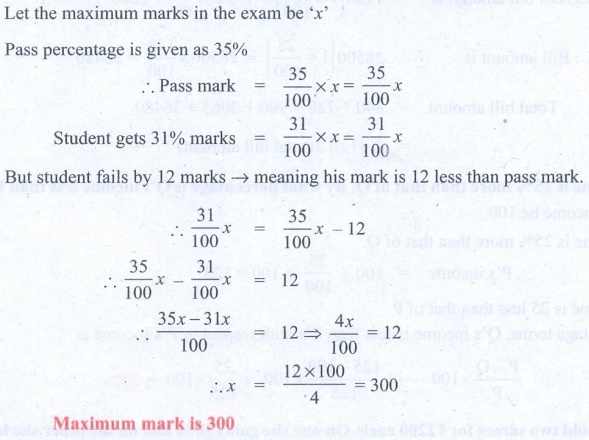
Solution 2:
Let the maximum marks in the exam be ‘x’
Pass percentage is given as 35%
∴ Pass mark = [35/100] × x
= [35/100]x
Student gets 31 % marks = [31 /100] × x = [31/100] x
But student fails by 12 marks → meaning his mark is 12 less than
pass mark.
∴ [31/100] x = [35 / 100] x − 12
∴ [35/100] x – [31/100] x = 12
∴ [35x − 31x
] / 100 = 12 ⇒ 4x / 100 = 12
∴ x = [12 × 100] / 4 = 300
Maximum mark is 300
3. Sultana bought the following things from a general
store. Calculate the total bill amount paid by her.
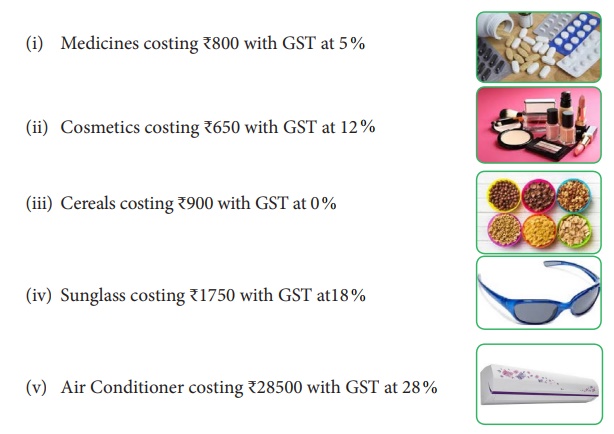
(i) Medicines costing ₹800 with GST at 5 %
(ii) Cosmetics costing ₹650 with GST at 12 %
(iii) Cereals costing ₹900 with GST at 0 %
(iv) Sunglass costing ₹1750 with GST
at18 %
(v) Air Conditioner costing ₹28500 with
GST at 28 %
Solution:

Solution 2:
Formula for bill amount is cost ( 1 + [GST % / 100] )
(i) Medicine : bill amount is 800 ( 1 + [5/100] ) = 800 × [105 /
100] = 840
(ii) Cosmetics: Bill amount is 650 ( 1 + [12 / 100] ) = 650 × [112
/ 100] = 728
(iii) Cereals : Bill amount is 900 (1 + [0 / 100] ) = 900
(iv) Sunglass: bill amount is 1750 (1 + [18/100] ) = 1750 ×
[118/100] = 2065
(v) AC : Bill amount is 28500 (1 + [28/100]) = 28500 × [128/100]
= 36480
∴ Total bill amount = 840
+ 728 + 900 + 2065 + 36480
= ₹ 41,013 (total
bill amount)
4. P’s income is 25 % more than that
of Q. By what percentage is Q’s income less than P’s?
Solution:
Let Q’s income be 100.
P’s income is 25% more than that of Q.
∴ P’s income = 100 + [ (25/100)
× 100 ] = 125
Q’s income is 25 less than that of P
In percentage terms, Q’s income is less than P’s with respect to
P’s income is

[(P – Q) / P] × 100 = [ (125 – 100) / 125] × 100 = [25 / 125] × 100
= 20%
5. Vaidegi sold two sarees for ₹2200
each. On one she gains 10 % and on the other she loses 12 % . Find her total gain
or loss percentage in the sale of the sarees.

Solution:

Solution 2:
Saree 1 :
The selling price is ₹ 2200, let cost price be CP1,
gain is 10%
Cost price? Using the formula
SP = CP1 (1 + [gain%/10] ) & substituting the
values
2200 = CP1 = ( 1 + [10/100] ) ∴
CP1 = 2200 × [100/110]
= 2000
Saree 2:
The selling price is 2200, let cost price be CP2,
loss is given as 12%. We need to find CP2 using the formula as
before,
SP = CP2 (1 + [loss%/100] ) & substituting the
values
2200 = CP2 (1 – [12/100] ) = CP2 × ( [100–12] / 100)
= CP2 × [88/100]
∴ CP2 = [2200 × 100] / 88 = 2500
∴ Cost price of both
together is CP1 + CP2
= 2000 + 2500 = 4500 …….. (1)
Selling price of both together is 2 × 2200 = 4400 …….. (2)
Since net selling price less than net cost price, there is a
loss.
Loss % = [ loss / cost price ] × 100
Loss = Net cost price − Net selling price
(1) – (2) = 4500 – 4400 = 100
∴ Loss % = [100/4500]
× 100 = 100/45 = 20/9 = 2 2/9 %
= 2 2/9 %
6. If 32 men working 12 hours a day can
do a work in 15 days, then how many men working 10 hours a day can do double that
work in 24 days?
Solution:
Let the required number of men be x.
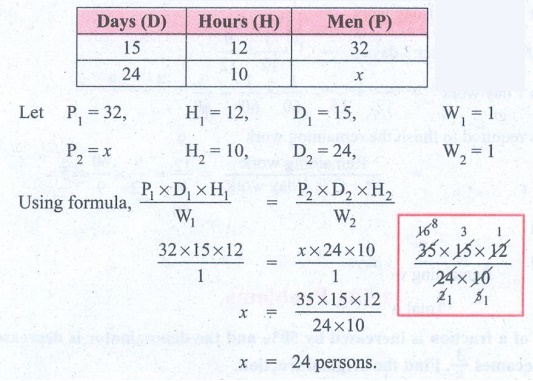
x = 24 persons.
To complete the same work 24 men needed.
To complete double the work 24 × 2 = 48 men are required.
7. Amutha can weave a saree in 18 days.
Anjali is twice as good a weaver as Amutha.If both of them weave together, then
in how many days can they complete weaving the saree?
Solution:
Amutha can weave a saree in 18 days.
Anjali is twice as good as Amutha.
ie. If Amutha weave for 2 days, Anjali do the same work in 1
day.
If Anjali weave the saree she will take
18 / 2 = 9 days.
Hence time taken by them together
= ab / [a + b] days
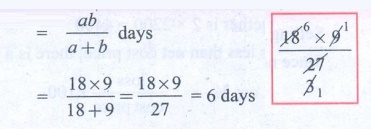
= [18 × 9] / [18 + 9] = [18
× 9] / 27 = 6 days
In 6 days they complete weaving the saree.
8. P and Q can do a piece of work in
12 days and 15 days respectively. P started the work alone and then after 3 days,
Q joined him till the work was completed. How long did the work last?
Solution:

Solution 2:
P can do a piece of work in 12 days.
∴ P's 1 day work = 1/12
P's 3 day's work = 3 × (1/12) = 3/12.
Q can do a piece of work in 15 days.
∴ Q's 1 day work = 1/15
Remaining work after 3 days = 1 – (3/12) = 9/12
(P + Q)'s 1 day work = 1/12 + 1/15 = 5/60 + 4/60 = 9/60.
∴ Number of days required to finish the remaining work
= Remaining work / (P + Q)'s 1 day work = [9/12] / [9/60] = [9/12]
× [60/9] = 5
Remaining work lasts for 5 days
Total work lasts for 3 + 5 = 8 days.
Challenging
Problems
9. If the numerator of a fraction is increased by 50 % and the denominator is decreased by 20 % , then it becomes 3/5. Find the original fraction.
Solution:
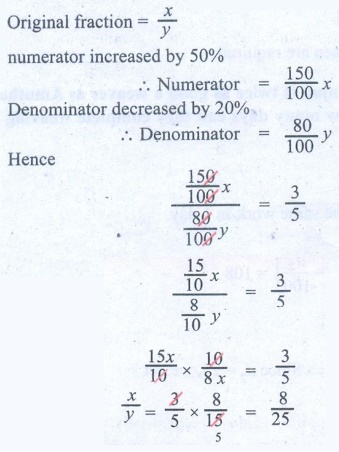
Solution 2:
Original fraction = x/y
numerator increased by 50%
∴ Numerator = [150 / 100] x
Denominator decreased by 20%
∴ Denominator = [80/100]
y
Hence
[ (150/100)x ] / [ (80/100)y ] = 3/5
[(15/10)x] / [(8/10) y ] = 3/5
[15x / 10] × [10 / 8x ] = 3/5
x/y = [3/5] × [8/15] = 8/25
10. Gopi sold a laptop at 12 % gain.
If it had been sold for ₹1200 more, the gain would have been 20 % . Find the cost
price of the laptop.

Solution:
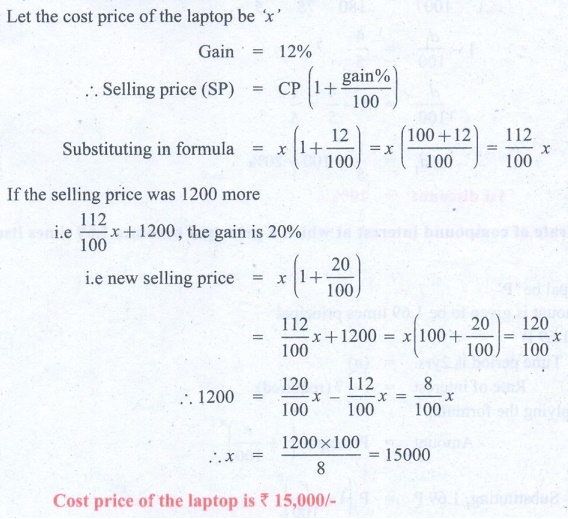
Solution 2:
Let the cost price of the laptop be ‘x ’
Gain = 12%
∴ Selling price (SP) = CP
(1 + [gain % / 100] )
Substituting in formula = x ( 1 + [12/100] ) = x (
[100 + 12]/100 ) = [112/100]x
If the selling price was 1200 more
i.e [112/100]x + 1200 , the gain is 20%
i.e new selling price = x (1 + [20/100] )
= [112/100] x + 1200 = x(100 + [20/100] ) =
[120/100]x
∴ 1200 = [120/100]x
– [112/100]x = [8/100]x
∴ x = [1200 × 100] / 8 = 15000
Cost price of the laptop is ₹ 15,000/−
11. A shopkeeper gives two successive
discounts on an article whose marked price is ₹180 and selling price is ₹108. Find
the first discount percentage if the second discount is 25% .
Solution:
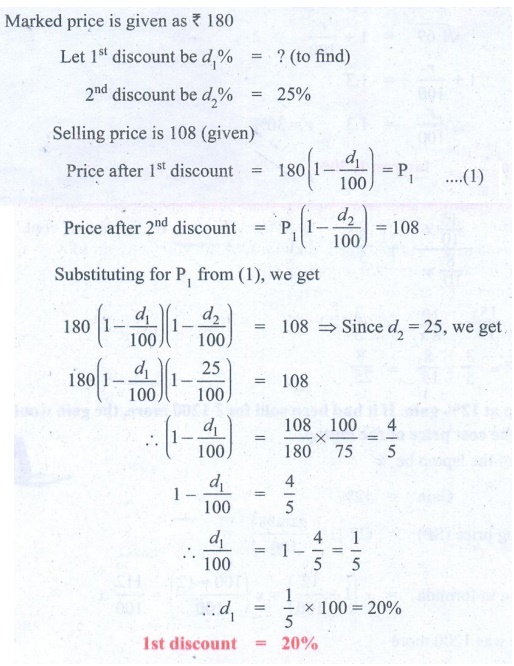
Solution 2:
Marked price is given as ₹ 180
Let 1st discount be d1% = ? (to
find)
2nd discount be d2 % = 25%
Selling price is 108 (given)
Price after 1st discount = 180 (1 – [d1/100]
) = P1 ………..(1)
Price after 2nd discount = P1 (1 – [d2/100]
) = 108
Substituting for P1 from (1), we get
180 (1 – [d1/100] ) (1 – [d2/100]
) = 108
⇒ Since d2 = 25, we get
180 (1 – [d1/100] ) (1 – [25/100] ) = 108
∴ (1 – [d1/100]
) = [108/108] × [100 / 75] = 4/5
1 – [d1/100] = 4/5
∴ d1 / 100 = 1 – [4/5] = 1/5
∴ d1 = [1/5]
× 100 = 20%
1st discount = 20%
12. Find the rate of compound interest
at which a principal becomes 1.69 times itself in 2 years.
Solution:
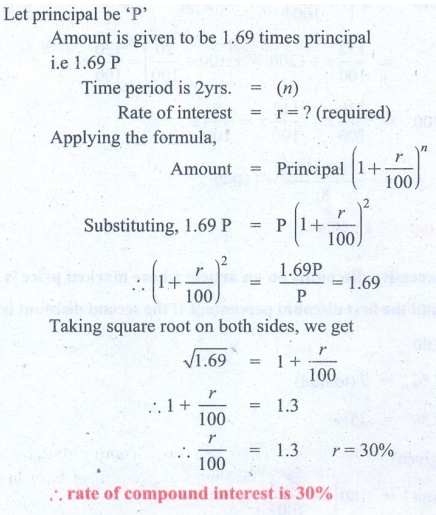
Solution 2:
Let principal be ‘P’
Amount is given to be 1.69 times principal
i.e 1.69 P
Time period is 2yrs. = (n)
Rate of interest = r = ? (required)
Applying the formula,
Amount = Principal (1 + [r/100] )n
Substituting, 1.69 P = P (1 + [r/100])2
∴ (1 + [r/100] )2
= 1.69P / P = 1.69
Taking square root on both sides, we get
√1.69 = 1 + [ r / 100 ]
∴ 1 + [ r / 100] =
1.3
∴ r / 100 = 1.3
r = 30%
∴ rate of compound
interest is 30%
13. A small–scale company undertakes
an agreement to make 540 motor pumps in 150 days and employs 40 men for the work.
After 75 days, the company could make only 180 motor pumps. How many more men should
the company employ so that the work is completed on time as per the agreement?
Solution:
Let the number of men to be appointed more be x.

To produce more pumps more men required
∴ It is direct variation.
∴ The multiplying factor
is 360/180
More days means less employees needed.
∴ It is Indirect
proportion.
∴ The multiplying factor
is 75/75
Now 40 + x = 40 × [360/180] × [75/75] 
40 + x = 80
x = 80 − 40
x = 40
40 more man should be employed to complete the work on time as
per the agreement.
14. P alone can do 1/2 of a work in 6
days and Q alone can do 2/3 of the same work in 4 days. In how many days will they
finish 3/4 of the work, working together?
Solution:
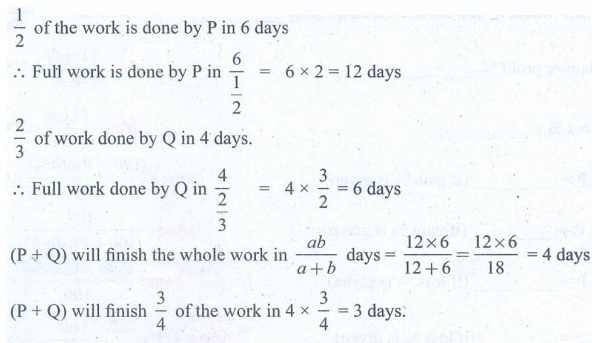
Solution 2:
1/2 of the work is done by P in 6 days
∴ Full work is done by P
in [ 6 /(1/2) ] = 6 × 2 = 12 days
2/3 of work done by Q in 4 days.
∴ Full work done by Q in [ 4 / (2/3) ] = 4 × 3/2 = 6 days
(P + Q) will finish the whole wotk in ab / [a + b]
days = [12 × 6] / [12 + 6] = [ 12 × 6] / 18 = 4 days
(P + Q) will finish 3/4 of the work in 4 × [3/4] = 3 days.
15. X alone can do a piece of work in
6 days and Y alone in 8 days. X and Y undertook the work for ₹48000.
With the help of Z, they completed the work in 3 days. How much is Z’s share?
Solution:
X can do the work in 6 days.
X's 1 day work = 1/6
X's share for 1 day = 1/6 × 48000 = ₹ 8,000
X's share for 3 days = 3 × 8000 = ₹ 24,000
Y can complete the work in 8 days.
Y's 1 day work = 1/8
Y's 1 day share = 1/8 × 48000 =
₹ 6,000
Y's 3 days share = ₹ 6000
× 3 = ₹ 18,000
(X + Y)'s 3 days share =
₹ 24,000 + ₹ 18,000 = ₹ 42,000
Remaining money is Z's share
∴ Z's share = ₹ 48,000 − ₹ 42,000 =
₹ 6,000
Exercise 4.5
Miscellaneous Practice
Problems
1. 400
2. 300
3. ₹38163
4. 20%
5. 2 2/9 % loss
6. 48 men
7. 6 days
8. 8 days
Challenging Problems
9. 8/25
10. ₹15000
11. 20 %
12. 30 %
13. 20 more men
14. 3 days
15. ₹ 6000
Related Topics